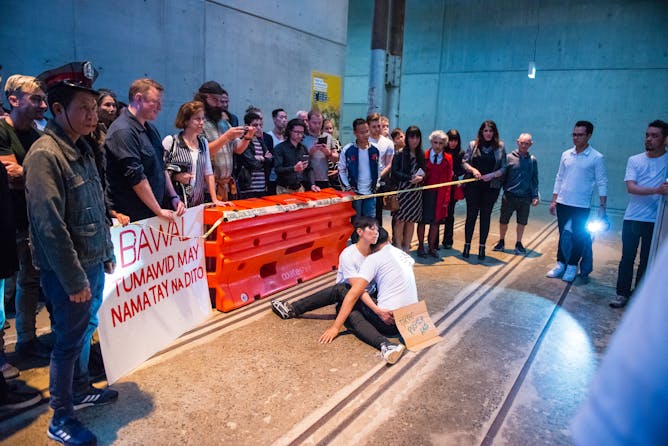|
Filipino president Rodrigo Duterte’s war on drugs is estimated to have led to the killing of at least 13,000 people, mostly in low-income neighbourhoods. As Anna Cristina Pertierra writes, artists are helping these communities work through the trauma of losing loved ones, including training victims to paint murals, and producing books for children.
And while we’re on the topic of art, prices for the high-end stuff have exploded in the last decade, most recently with the US$450 million sale of Leonardo da Vinci’s Salvator Mundi. The reason is a mix of investment and consumption, according to Bronwyn Coate. While research shows art is a spotty investment, works by famous artists are coveted by the rich and powerful. And what they don’t get in financial returns they receive in flaunting their taste, wealth and power.
|

In This Here. Land, a performance by Filipino and Australian artists in Sydney, the audience is asked to participate in a recreation of one of the Philippines’s drug killings.
Jade Cadeliña
Anna Cristina Pertierra, Western Sydney University
Filipino president Rodrigo Duterte's 'War on Drugs' is estimated to have led to more than 13,000 killings. Artists - both in the Philippines and beyond - are helping communities work through their trauma.
|
Business + Economy
|
-
Bronwyn Coate, RMIT University
Research shows paintings aren't always good investments. The reason for sky-high prices paid for high-end art is likely due to other factors.
|
|
Environment + Energy
|
-
Fiona Nunan, University of Birmingham
Social ties between Lake Victoria's fisherfolk are critical for gaining access to credit, employment, maintaining reliable and skilled labour and access to markets.
|
|
Health + Medicine
|
-
Mariana Brussoni, University of British Columbia; M. Anne George, University of British Columbia
Research shows that Indigenous women are at greatest risk of injury within Canada. Income, education and housing inequities play a role. So does systemic racism and post-colonial trauma.
|
|
Politics + Society
|
-
Yvonne Rowa, University of Adelaide
By intervening in Zimbabwe's politics the military could plunge the country into a prolonged period of uncertainty. Could President Emmerson Mnangagwa be its saviour?
-
Beverley Milton-Edwards, Queen's University Belfast
Much of Sinai is almost beyond Egyptian state control altogether.
-
Peter Gottschalk, Wesleyan University
A new attack on a Sufi mosque in Egypt drives home the hatred of Islamic State and other some other Muslim groups for the Sufi traditions of inclusiveness and mystical worship.
-
Francois Cleophas, Stellenbosch University
Sport participation in South Africa remains rooted in the dilemmas of colonial society. It necessitates an ongoing need for discourse, debate and dialogue on decolonisation in sport history.
|
|
Science + Technology
|
-
George Hobbs, CSIRO; Dick Manchester, CSIRO; Simon Johnston, CSIRO
In mid 1967, PhD student Jocelyn Bell at Cambridge University was helping to build a telescope. She went on to discover a little bit of "scruff" - the first evidence of a pulsar.
|
|